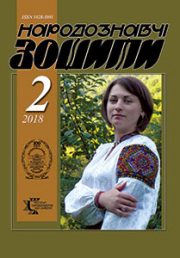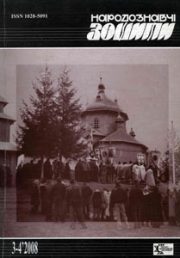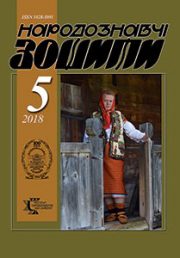The Ethnology Notebooks. 2023. № 4 (172), 850—857
UDK 069.014:[304.44+93|99+7]:[061.2:001](045)(477.83-25)
DOI https://doi.org/10.15407/nz2023.04.850
KUSHNIR Vitalii
- ORCID ID: https://orcid.org/0000-0001-8809-0108
- Candidate of Historical Sciences,
- Senior Research Fellow,
- Museum of Ethnography and Art Crafts
- Of the Institute of Ethnology of the National Academy of Sciences of Ukraine,
- Svobody ave., 15, 79000,. Lviv,. Ukraine,
- Contacts: e-mail: vitaliy_val@ukr.net
Abstract. In the period between the two world wars, the Shevchenko Scientific Society Museum played the role of one of the most active Ukrainian cultural centres of Lviv and Galicia. In the conditions of a clearly defined demarcation of the social and cultural life of the main ethnic communities in the western Ukrainian territories, as well as disproportionate distribution of public funds by the authorities, primarily in favour of the Poles, the functioning of such cultural institutions required significant voluntary efforts of the Ukrainian community.
The purpose of the article is to highlight the history and peculiarities of the work of the Cultural and Historical Museum of the Shevchenko Scientific Society as an important location of the entire dynamic cultural space of the Ukrainian community of Lviv, in particular, in its cross-border and international dimensions. At the same time, the focus of attention is the holding of exhibitions in the museum, which often became a resonant event of artistic, cultural and social life of the city.
The chronological framework of the work covers the period of the 1920s—1930s, that is, the time when Lviv was under the rule of the Polish state.
Conclusions. In the interwar period the Museum of the Shevchenko Scientific Society became one of the important «nodes» of the whole network of social and cultural communication of the Ukrainian community of Lviv. The maintenance of the institution’s activities required significant voluntary efforts of members of the Ukrainian community, embodied, in particular, in the work of the Society of Museum Supporters. The core of the functioning of the museum as a Ukrainian centre of a multi-ethnic city was the holding of art and educational exhibitions on its rooms. Their organization required the combined efforts of museum workers themselves, Ukrainian artists, photographers, scientists and educators. Arousing the lively interest of the press, exhibitions in the museum became, therefore, multidisciplinary cultural projects, also significant from the point of view of the institution’s financial interests. They also promoted cooperation between Ukrainian museum institutions, acted as an effective stimulus for the cultural and social life of the Ukrainian community in various countries.
The research methodology is based on the complex involvement of a number of principles and methods of museology and historical research, in particular, the principle of historicism, the comparative method, as well as art analysis, primarily visual and formal-stylistic.
Keywords: Museum of the Shevchenko Scientific Society, museology, ethnography, exhibitions, Ukrainian creative unions.
Received 5.07.2023
REFERENCES
- Gah, I. (2013). Great gift of the Metropolitan (III). Retrieved from: zbruc.eu/node/13966 (access date 05/17/2023) [in Ukrainian].
- Holod, I.V. (2001). Association of Independent Ukrainian Artists. ESU. Kyiv: Institute of Encyclopedic Research of the National Academy of Sciences of Ukraine. Retrieved from: https://esu.com/ua/article-44472 (access date: 05/23/2023) [in Ukrainian].
- Gah, I. (2016). ANUM: in step with European art. Retrieved from: https://photo-lviv.in.ua/anum-v-nohu-z-jevropejskym-mystetstvom/ (access date: 06/ 06/2023) [in Ukrainian].
- Regheilo, Z. (2019). The Association of Independent Ukrainian Artists in Galicia (1931—1939): the thorny path of integration into the European cultural space. Retrieved from: https://shron1.chtyvo.org.ua/Reheilo_Zinovii/Asotsiatsiia_nezalezhnykh_ukrainskykh_myttsiv_u_Halychyni_1931_1939.pdf (date of application: 01.06.2023) [in Ukrainian].
- Volynska, O. (2005). Contribution to the development of artistic education of Galician artists. Retrieved from: http://elibrary.kdpu.edu.ua/bitstream/123456789/6103/4/pdf24_merged-58-80.pdf (access date: 05/21/2023) [in Ukrainian].
- (1933). Catalogue of the exhibition of images organized by the NTSh and the «Ukrainian Society of Art Supporters» in Lviv. Lviv [in Ukrainian].
- Beregovska, H. (2019). Sviatoslav Gordynskyj. Artist works for a half of century. Lviv: Apriory [in Ukrainian].
- Artymishyn, P. (2023, january 23). Journalist of «The Manchester Guardian» with Oleksa Novakivskyi at the exhibition in Lviv. Retrieved from: https://localhistory.org.ua/rubrics/photo/zhurnalist-the-manchester-guardian-z-oleksoiu-novakivskim-na-vistavtsi-u-lvovi/ (access date: June 2, 2023) [in Ukrainian].
- Hor, S. (1934). Exhibition of drawings in the museum of the Scientific Society named after Shevchenko. Towards. Lviv [in Ukrainian]
- (1933). ANUM. Exhibition of drawings and engravings by Olena Kulchytska. Museum of the Shevchenko Scientific Society. Catalogue. Lviv [in Ukrainian].
- (2000). Vedeneev, D., & Shevchenko, S. Scout «Yarema» and underground «Zot». Retrieved from: https://zn.ua/ukr/SOCIUM/rozvidnik_yarema_i_pidpilnik_zot.html 18.08.2000 (date of application: 05/14/2023) [in Ukrainian].
- Patron, I. (2020). Photographer and film director Yulian Dorosh is a popularizer of Ukrainian photography. Ukrainian literary studies, 85, 1—22. DOI: http://dx.doi.org/10.30970/uls.2020.85.3158 [in Ukrainian].
- Central State Arhives of Ukraine in Lviv. F. 309. Op. 2. Ref. 29. Ark. 2 [in Ukrainian].
- U. S. (1935). Our Motherland in Photo. New House, 22 [in Ukrainian].
- (1938). Ukrainian Photographic Society. The eighth exhibition of Ukrainian art photography. Museum of the Shevchenko Scientific Society. Lviv [in Ukrainian].
- Stasiv, V. (2014). The role of the «Revival» society in the movement for the sobriety of Galicia in the 1920s—1930s. Scientific bulletin of the Uzhhorod University. «History» series (Vol. 1 (32), pp. 37—40) [in Ukrainian].
- (1933). Chronicle of the Shevchenko Scientific Society (Vol. 71). Lviv [in Ukrainian].
- Nyzhankivska, M. (1935, october 1). Exhibition of folk fabrics and embroideries. New house. Lviv [in Ukrainian].
- (1937). Chronicle of the Shevchenko Scientific Society (Vol. 73) [in Ukrainian].
- Savenko, T. (2014). International scientific activity of members of the National Academy of Sciences in the interwar period. Scientific notes of Ternopil National Pedagogical University named after Volodymyr Hnatyuk. Series: History (Issue 1, part 3, pp. 40—45). Ternopil [in Ukrainian].
- (1938). Ethnographic exhibition of Polissia in the Museum of the Scientific Society named after Shevchenko. Shevchenko Scientific Society. Our Motherland (Part 4, pp. 108—109) [in Ukrainian].
- (1939). Chronicle of the Shevchenko Scientific Society (Part 74). Lviv [in Ukrainian].
- Sydor, O. (1995). Lev Gets and the «Lemkivshchyna» museum in Syanok. Historical Sights of Ukraine, 3, 153—158) [in Ukrainian].
- State Arhives of Lviv Oblast. F. 1245 (Sambir museum of the «Boikivshchyna» society). Op. 1. Ref. 94. Ark. 104 [in Ukrainian].
- Central State Archives of Ukraine in Lviv. F. 309 (Shevchenko Scientific Society, Lviv). Op. 1. Ref. 180. Ark. 98 [in Ukrainian].
- Kushnir, V. (2021). The Museum of the Shevchenko Scientific Society (1892—1940). Lviv [in Ukrainian].






